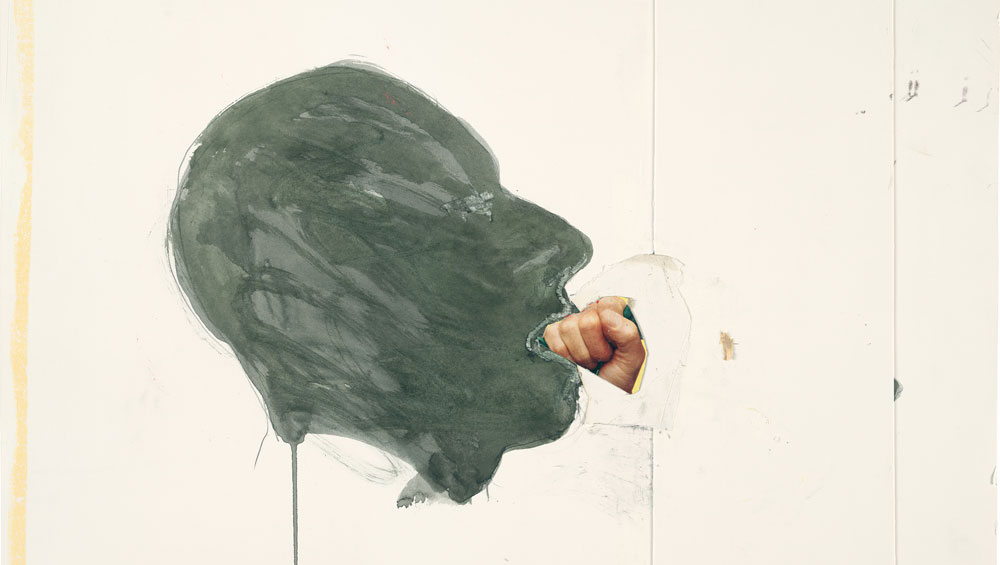
Bruce Nauman. Fist in Mouth, 1990. The Museum of Modern Art, New York. © 2018 Bruce Nauman/Artists Rights Society (ARS), New York. Digital image © 2018 The Museum of Modern Art, New York. Photo: John Wronn.
Museum of Modern Art, New York
21 October 2018 – 18 February 2019
MoMA PS1
21 October 2018 – 25 February 2019
by NATASHA KURCHANOVA
It is impossible to remain merely contemplative when visiting Disappearing Acts, the Bruce Nauman retrospective at MoMA, not only because Nauman’s art is participatory in nature, but also because the exhibition is divided between two buildings – the centrally located MoMA on West 53rd Street in Manhattan and MoMA PS1 in Queens. Even if it takes only 15 minutes to get from one location to the other, in order to hail a cab or walk to the subway, you still need to go outside, where you are exposed to the forces of nature, your art-viewing experience interrupted by unexpected intrusions from the outside world. This disruption of the viewer’s contemplative art-viewing mode by the intrusions of daily life is completely in line with Nauman’s aesthetic – in fact, it is all about it. This retrospective teaches us to see Nauman’s art in a larger context, which helps us to uncover its political dimension, what Nauman calls taking “a moral stance, a position”.1
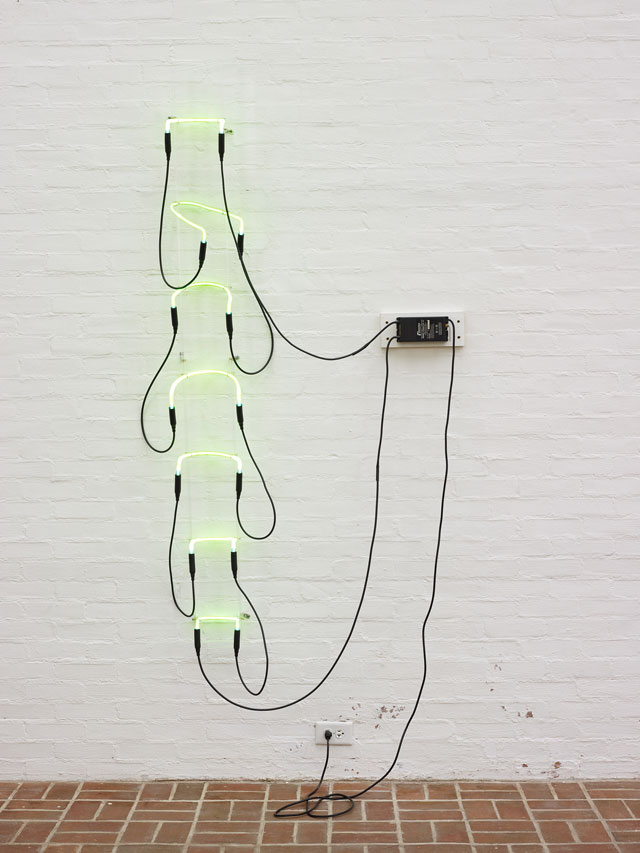
Bruce Nauman. Neon Templates of the Left Half of My Body Taken at Ten-Inch Intervals, 1966. Neon tubing with clear glass tubing suspension frame, 70 × 9 × 6 in (177.8 × 22.9 × 15.2 cm). Philip Johnson Glass House Collection, National Trust for Historic Preservation. © 2018 Bruce Nauman/Artists Rights Society (ARS), New York. Photo: Andy Romer Photography, courtesy of the Glass House, a site of the National Trust for Historic Preservation.
The politics of Nauman’s aesthetics does not strike you immediately but becomes apparent when you reflect on the exhibition as a whole. The retrospective begins in either of the two locations with a reference to the artist’s main subject – himself, his body and his immediate working environment. Despite the focus on the body, the exhibition makes clear that the physical reality of this body, its sense of aliveness and vitality, are constantly being undermined by a structure that is imposed by society, either in a physically tangible form, such as an architectural enclosure, or an intellectually demanding one – an art movement (such as minimalism), a grammatical or pictorial convention (such as a frame), or a philosophy (that of Ludwig Wittgenstein, for example).

Bruce Nauman: Disappearing Acts. Installation view at MoMA PS1, New York (October 21, 2018–February 25, 2019, at MoMA and MoMA PS1). © 2018 Bruce Nauman/Artists Rights Society (ARS), New York. Digital image © 2018 The Museum of Modern Art, New York. Photo: Martin Seck.
The success of the exhibition is determined in large measure by the ability of its organisers to think through this conundrum in Nauman’s expansive oeuvre in equally expansive terms and to come up with a suitable metaphor for it – that of “disappearance”.2 This word helps us to understand Nauman’s diverse work, which coheres as a laborious and painful process of measuring himself against these confining structures and resisting them by making the discomfort, fragmentation, displacement and the eventual escape of his physical body not only visible but also palpable somehow. By virtue of being a white male, Nauman made this process symbolic of the struggles of white males in general, a demographic traditionally excluded from the realm of the suffering and the downtrodden.

Bruce Nauman. Myself as a Marble Fountain, 1967. Ink with wash, 19 × 24 in (48.3 × 61 cm). Emanuel Hoffmann Foundation, on permanent loan to the Öffentliche Kunstsammlung Basel. © 2018 Bruce Nauman/Artists Rights Society (ARS), New York. Photo: Kunstmuseum Basel, Martin P. Bühler.
The curatorial team, led by Kathy Halbreich of the Laurenz Foundation, has arranged Nauman’s vast and technologically diverse body of work in such a way that the Manhattan MoMA’s sixth floor holds about a third of the works, with the rest displayed at PS1 in Queens. Even though the exhibition in Queens is more comprehensive, the Manhattan contingent contains an exquisite selection of works embracing the entirety of the artist’s career and offering a general idea about his thinking, materials and work process. There, the retrospective opens, appropriately, with early work from the mid-60s, in which Nauman struggled to find his identity vis-a-vis the minimalist and pop art aesthetic that dominated the zeitgeist. He made it personal, directing attention to his own body. He also made it abstract, emphasising the absence of this body. In From Hand to Mouth (1967), for example, we see a wax impression of his mouth, shoulder and extended arm, with the rest of the body absent. In Glass Templates of the Left Half of My Body Separated by Cans of Grease (1966), he refers to Warhol with the cans and to minimalism with the sheets of glass and, of course, to himself, but his body, the imprint of which is left on the work, is not there.
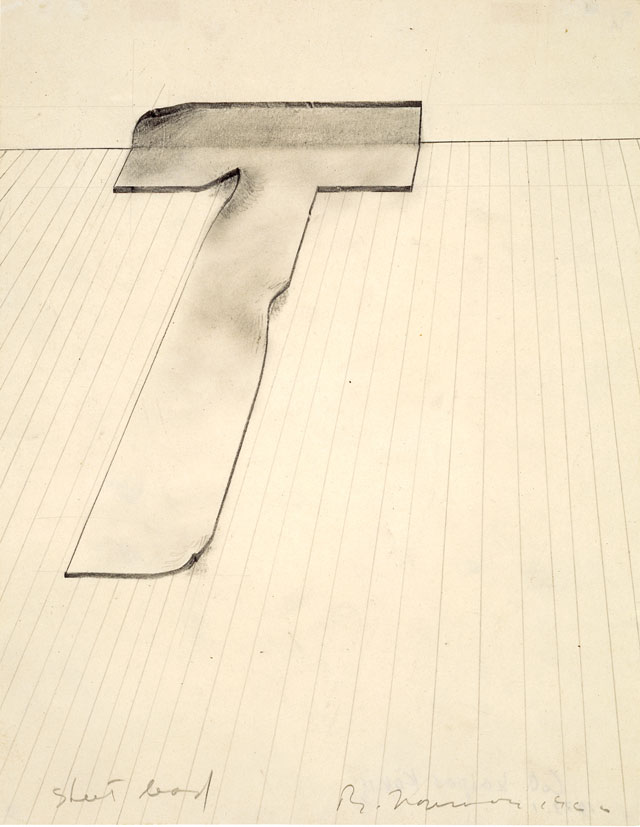
Bruce Nauman. Sheet Lead, 1966. Pencil, 11 × 8 1/2 in (27.9 × 21.6 cm). Emanuel Hoffmann Foundation, on permanent loan to the Öffentliche Kunstsammlung Basel. © 2018 Bruce Nauman/Artists Rights Society (ARS), New York. Photo courtesy Kunstmuseum Basel, Martin P. Bühler.
In another reflection on minimalism, a 1965 film called Manipulating the T-Bar, Nauman does exactly what the title says, moving around a metal, industrially made object, typical of minimalist-inspired aesthetics. The artist looks confounded as to what to do with this unwieldy thing, as he picks it up and puts it down, changing its position on the floor relative to the geometry of the room. The intertitle separating this film from its sequel, Sound Effects for Manipulating the T-Bar (1966), explains that we are watching a “film of an actor pretending to be myself making a tape of the sound effects of the film Manipulating the T-Bar”. We then see not an actor, but Nauman himself knocking two small bars of steel together to produce the sound effects, but we do not hear them because the film is silent. In this short sequel, Nauman estranges himself from his own representation literally and metaphorically, by calling himself an actor and by looking at his image from the side. This act of looking at an image of himself dispassionately, as if observing someone else, empties the body of its life and singularity, making it an abstract and deceptive cipher. Along with the artist’s body, the sound in the film also loses its materiality, while being replaced by a mute image.
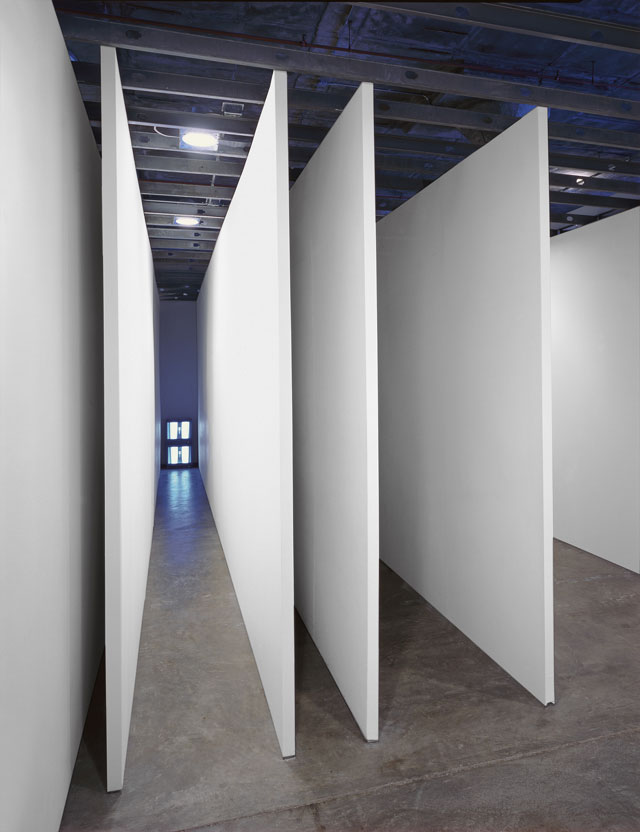
Bruce Nauman. Corridor Installation (Nicholas Wilder), 1970. Wooden wallboards, water-based paint, three video cameras, scanner, frame, five monitors, video recorder, video player, and videotape (black and white, silent), dimensions variable (11 × 40 × 30 ft (335.3 × 1,219.2 × 914.4 cm) as installed at Nicholas Wilder Gallery, Los Angeles, in 1970). Friedrich Christian Flick Collection im Hamburger Bahnhof, Berlin. © 2018 Bruce Nauman/Artists Rights Society (ARS), New York. Photo courtesy Friedrich Christian Flick Collection im Hamburger Bahnhof, Berlin.
Nauman’s later works, shown in Manhattan, demonstrate a shift from performance and sculpture to installation of large-scale “participatory structures”, as they are referred to in a wall text. In the 70s installations, it is not only the artist’s body, but also that of the viewer that enters Nauman’s built environment. In the next room, we see Going Around the Corner Piece (1970), in which the cameras are installed in such a way that we can watch our image on a monitor shown at a strange angle, as if we were someone else, our body digitised, doubled, reduced in size and removed in space, estranged from breath and life.
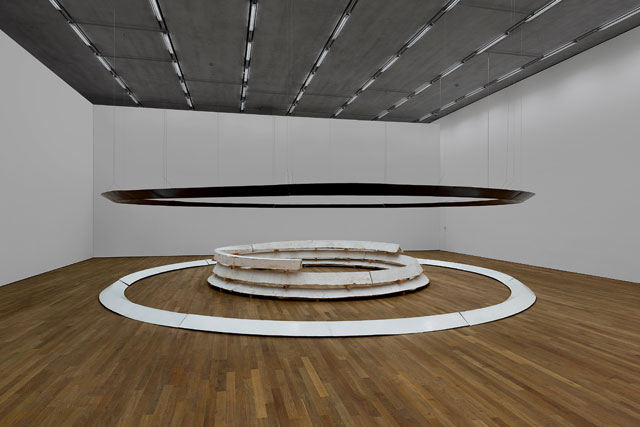
Bruce Nauman. Model for Trench and Four Buried Passages, 1977. Plaster, fibreglass and wire, 65 × 360 in (165.1 × 914.4 cm) dia outer circle; 192 in (487.7 cm) dia inner circle. Glenstone Museum, Potomac, Maryland. © 2018 Bruce Nauman/Artists Rights Society (ARS), New York.
In the Audio-Video Underground Chamber (1972-74), the artist installed a camera in front of an empty concrete chamber, where there is no movement or sound. The actual chamber equipped with a recording video camera and a microphone is buried underground in the museum of modern art in Vienna, but an image of a still, hollow, geometric space emanating from a monitor has a disquieting effect, triggering feelings of entrapment and claustrophobia. The sense of confinement also figures in Model for Trench and Four Buried Passages (1977), a giant labyrinth-like structure, which the visitor can’t enter, but can imagine being lost in for ever. Like much of Nauman’s work, it is an entrapment that affects our imagination.
Kassel Corridor: Elliptical Space (1972) is an entrapment that affects our body as well as our mind. A curved wall of this long, high corridor has a locked door at its centre. A key to the door is given to one person for up to an hour; and it is not to be shared with anyone. In this work, I can choose to accept the key, and if I do, I will become trapped. When I enter the corridor, there is just enough space for me to stand squeezed between the two walls of the structure. The narrow slits at each end remain open, so that others can see me standing inside. Here, Nauman gives me a chance to put myself in the position of being entrapped and kept under surveillance.
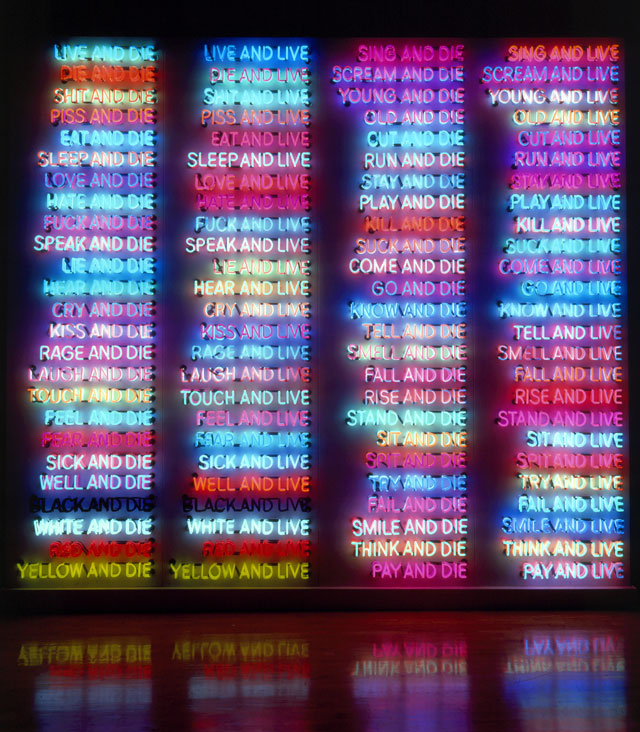
Bruce Nauman. One Hundred Live and Die, 1984. Neon tubing with clear glass tubing on metal monolith, 118 × 132 1/4 × 21 in (299.7 × 335.9 × 53.3 cm). Collection of Benesse Holdings, Inc./Benesse House Museum, Naoshima. © 2018 Bruce Nauman/Artists Rights Society (ARS), New York. Photo: Dorothy Zeidman, courtesy the artist and Sperone Westwater, New York.
Even the “imaginary spaces” he creates, which do not provoke claustrophobia but are open and filled with sound and light, offer us no reliable escape from being caught in a system. In One Hundred Live and Die (1984), one of many neon works in which Nauman experimented with language, he used it to create threatening verbal dichotomies – such as “speak and live” or “smile and die” – that conjure up murderous scenarios to haunt our imagination. In the installation Days (2009), he filled a large room with uniform white rectangular panels hanging from the ceiling, with a soundtrack that endlessly repeats the days of the week in a multiplicity of monotonous voices. The experience of this work makes us aware of a possibility of being entrapped not only by language, but also by time itself.

Bruce Nauman: Disappearing Acts. Installation view at MoMA PS1, New York (October 21, 2018–February 25, 2019, at MoMA and MoMA PS1). © 2018 Bruce Nauman/Artists Rights Society (ARS), New York. Digital image © 2018 The Museum of Modern Art, New York. Photo: Martin Seck.
All the themes of the exhibition in Manhattan can be found in the PS1 in Queens, albeit broken down into more specific categories, focusing on Nauman’s interest in such topics as “vision”; “the figurative tradition”; “new ways of making sculpture” and others. Despite different section labels, here we see more of Nauman’s “participatory structures”, such as corridors equipped with surveillance cameras and video monitors and room-size installations that often give us no choice but to become subject to haunting images, threatening voices and claustrophobic entrapments. We are also introduced to the artist’s interest in “animal nature” and works made after 1979, when he escaped from civilisation to the desert in New Mexico, where he has continued to live. More than anything, however, the PS1 exhibition makes explicit Nauman’s life-long involvement in performance and his adept adaptation of technology – film, photography and video – to publicly display his art.
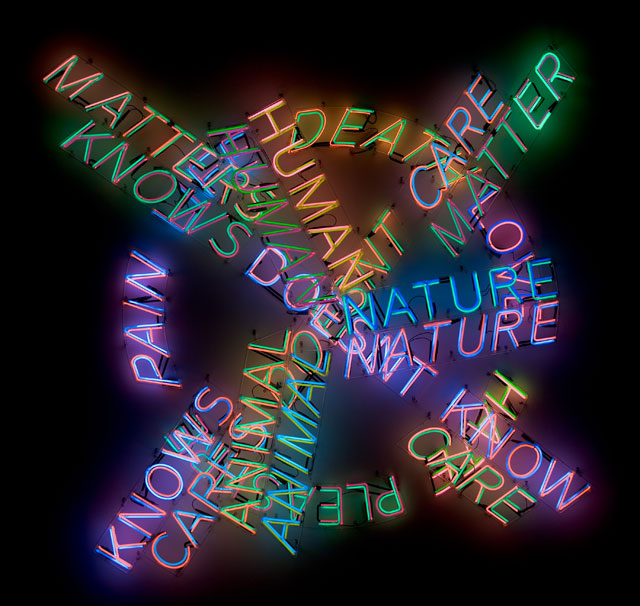
Bruce Nauman. Human Nature/Life Death/Knows Doesn’t Know, 1983. Neon tubing with clear glass tubing suspension frames, 107 1/2 × 107 × 5 3/4 in (273.1 × 271.8 × 14.6 cm). Los Angeles County Museum of Art, Modern and Contemporary Art Council Fund. © 2018 Bruce Nauman/Artists Rights Society (ARS), New York. Photo © Museum Associates/LACMA.
Technology helps Nauman amplify the effect of his work and confirms his critique of vision as the sense not to be trusted. On entering the PS1 building, for example, one of the first things that catches our attention is not something visual, but drone music. Early on in his career, Nauman played in a drone band and was interested in composers such as Philip Glass and La Monte Young.3 In the basement, a three-channel video installation, End of the World (1996), serves as the source of the sounds permeating the first floor of the building and creating a background for viewing the works. In the lobby of PS1, we see visual works referencing music, among them the neon Violins Violence Silence (1981-82). Further on, we see more performance-oriented works, such as photographs of his design for Merce Cunningham’s production of Tread (1970), for which Nauman installed a row of fans blowing air at the audience.

Bruce Nauman: Disappearing Acts. Installation view at MoMA PS1, New York (October 21, 2018–February 25, 2019, at MoMA and MoMA PS1). © 2018 Bruce Nauman/Artists Rights Society (ARS), New York. Digital image © 2018 The Museum of Modern Art, New York. Photo: Martin Seck.
We also can watch a video of his film Dance or Exercise on the Perimeter of a Square (1967-68), as well as a re-enactment of the original score of his Wall-Floor Positions (1965), by a live performer. The video of this work performed by Nauman in 1968 is shown on the third floor, but in this re-enactment, a performer is assuming and holding different postures in relation to the surrounding architecture of a wall and a floor: crouching, bending down and touching the floor, leaning, lying prone. This performance requires strength and endurance, as well as an onlooker who can provide “a certain sympathetic response” to the performer’s challenges. In his text for the exhibition catalogue, dancer Ralph Lemon (b1952) wrote about the political dimension of Wall-Floor Positions, explaining his reason for asking the artist for permission to re-enact it as part of a commissioned dance: “What interested me about Wall-Floor positions … beyond its fresh relationship to art and the body … were not so obvious parallel realities of its complex historical period. Specifically, there was a particular projection of white-male autonomy taking place concurrently with the exigencies of the black civil rights movement, with its culturally defined lack of autonomy, creative and otherwise, and its resistance to organizational racism.”4
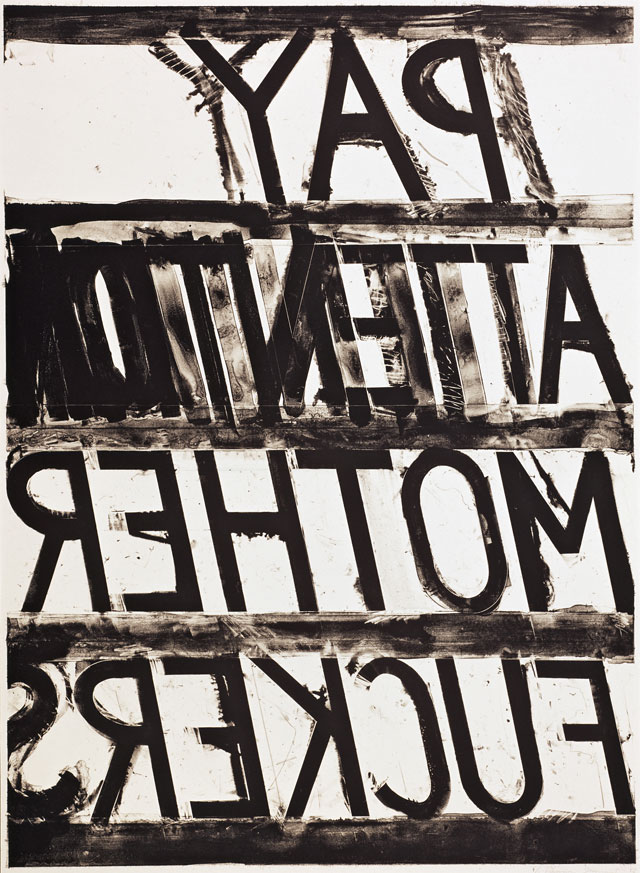
Bruce Nauman. Pay Attention, 1973. Lithograph, edition of 50; each 38 1/4 × 28 1/4 in (97.2 × 71.8 cm). Collection Robin Wright and Ian Reeves. © 2018 Bruce Nauman/Artists Rights Society (ARS), New York. Photo: Pay Attention, © 1973 Bruce Nauman and Gemini G.E.L.
Another example of Nauman’s more explicit political statement is his powerful Art Makeup: No 1 White, No 2 Pink, No 3 Green, No 4 Black (1967-68) in which he slowly and methodically applies makeup that changes the colour of his skin, depriving himself of a symbolic attribute of white male identity. On the second floor, there is a series of videos made in 1969 in which Nauman goes further in this exploration. In Black Balls, which the artist Nicolás Guagnini (b1966) calls “the most disturbing” of Nauman’s video works, the artist paints his testicles black and manipulates them with his hand for several minutes. Shown in closeup, this video is difficult to watch, because it stirs a variety of feelings from disgust to fascination to abject desire. According to Guagnini, in this video, the artist “imagines himself as black by painting his testicles, thus inscribing himself into the marginalised and mythified domain of black male sexuality and the fantasies of power and fear that it elicits …”5 Here, Nauman creates a disturbing image that references a threatening fantasy of black sexual potency and power.
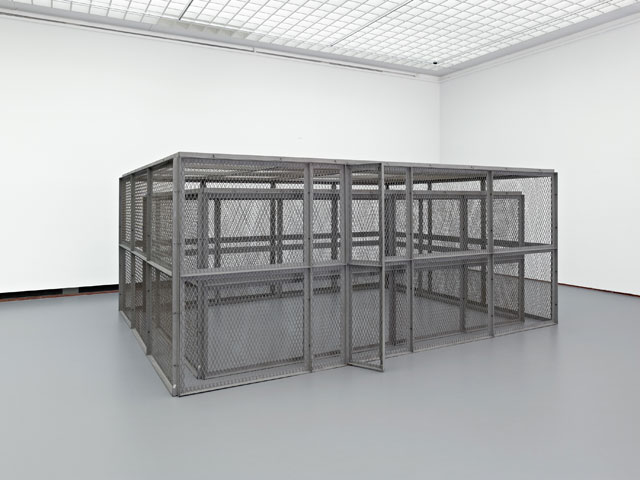
Bruce Nauman. Double Steel Cage Piece, 1974. Steel, 84 11⁄16 × 154 5⁄16 × 204 11⁄16 in (216 × 392 × 520 cm). Museum Boijmans van Beuningen, Rotterdam. © 2018 Bruce Nauman/Artists Rights Society (ARS), New York. Photo: Jannes Linders, Rotterdam.
This retrospective is extremely well curated, with clear demarcations of principal themes that have preoccupied the artist throughout his career, with the reflection on the role of the artist as one of his central subjects. The exhibition begins and ends with works that give two alternate definitions of this role: at the entrance to the retrospective in MoMA Manhattan, we see a rectangular poster that reads along its perimeter: “The True Artist is an Amazing Luminous Fountain.” This work, made in 1966, echoes a neon sign made the following year that concludes the exhibition in PS1 with the words: “The True Artist Helps the World by Revealing Mystic Truths.” While complementing each other, these sardonic statements create a repetitive discursive space into which it is possible to fit Nauman’s entire production. The main actor in this drama is the artist himself, as becomes particularly clear when visiting the installation at PS1.
There, the idea of the artist as a measure of truth is reflected in a series of works on the theme of contrapposto, a standard posture for human figure, usually male, in classical Greek sculpture, in which the figure is shown standing with its weight resting on one leg, with the other leg slightly bent at the knee and the hips tilted. In Walk with Contrapposto (1968), shown on a bulky TV monitor, we see a young and lithe Nauman walking along a corridor just wide enough to fit a human body. He swings his hips sideways with every step. While in classical Greece, contrapposto was meant to imbue the male figure with the sense of aliveness and vitality, Nauman’s enactment of this posture is nothing but parodic in his exaggerated swinging of hips – which nearly hit the walls of the corridor with every step he takes, and in the monotonous and seemingly endless process of his pacing back and forth along this confining structure. The artist holds his arms up and puts them behind his head; most of his face and his head are cut off by the frame. If anything, he looks more like a prisoner undergoing unusual punishment than any ideal of male beauty, which Greek sculpture procures.
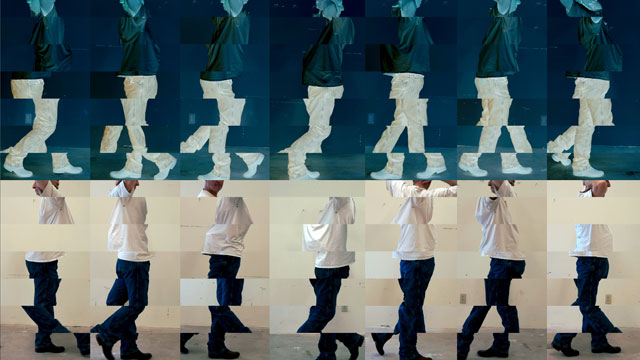
Bruce Nauman. Contrapposto Studies, i through vii, 2015/16. Seven-channel video (colour, sound, continuous duration), dimensions variable. The Museum of Modern Art, New York. Jointly owned by The Museum of Modern Art, New York, acquired in part through the generosity of Agnes Gund and Jo Carole and Ronald S. Lauder; and Emanuel Hoffmann Foundation, on permanent loan to Öffentliche Kunstsammlung Basel. © 2018 Bruce Nauman/Artists Rights Society (ARS), New York. Photo courtesy the artist and Sperone Westwater, New York.
The impression of a prescribed and dull routine is reinforced by videos Nauman made nearly half a century later with considerably more advanced technology. In Contrapposto Studies i through vii (2015/16) and Contrapposto Split (2017), the figure of a much older artist is shown full-face, assuming the same gait in the same pose either in an undefined space or in his studio. Instead of being enclosed in a tiny monitor, his image looms large across several exhibition halls on the first and second floor of PS1, repeated several times and amplified by splits, 3D technology and other visual effects. Despite these technological advances, there is the same dull, monotonous routine of an endless walk into nothingness, albeit with carefully measured steps. Clearly, Nauman’s success enabled him to display himself on a larger scale and with more visibility, but his relationship to his environment and to himself did not change. Reflecting on the contrapposto works helps us to understand Nauman as an artist who turns attention to himself, his body and his image as an object of exploration in its relation to time, place and history, history of art in particular. This is a relationship based on borrowings and repetitions and a continuous process of adjustment of these archaeological findings to new means of experiencing old truths.
References
1. White Male/Black Balls by Nicolas Guagnini. In Bruce Nauman: Disappearing Acts, New York: Museum of Modern Art, 2018, pages 144-148; page 145.
2. Disappearing Acts Appear by Kathy Halbreich. In Bruce Nauman: Disappearing Acts, New York: Museum of Modern Art, 2018, pages 23-31; page 23.
3. Neon Sign None Sing by Glenn Ligon. In Bruce Nauman: Disappearing Acts, New York: Museum of Modern Art, 2018, pages 162-167, page 165.
4. Positions by Ralph Lemon. In Bruce Nauman: Disappearing Acts, New York: Museum of Modern Art, 2018, pages 116-123; page 118.
5. White Male/Black Balls by Nicolas Guagnini, op cit, page 146.